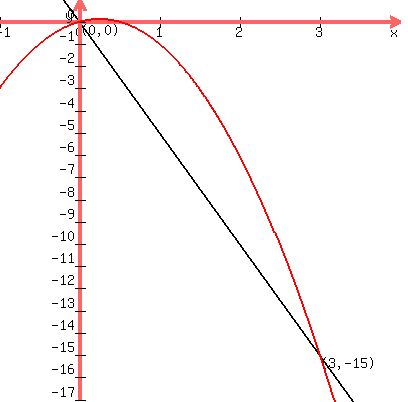For h(x) = -2x^2 + x,
A. Find the average rate of change from 0 to .As x goes from 0 to 3, y [or h(x)] goes from h(0)=-2(0)^2 + 0=0 to h(3)=-2(3)^2 + (3)=-15
From 0 to -15 is a change of (-15)-(0)=-15 in y
From 0 to 3 is a change of (3)-(0) = +3 in x
So the average change in y [or h(x)] per the +3 average change in x
is -15 units change in y per a +3 change in x, which means an average
change of (-15)/(+3)=-5 y-units change per x-units change.
That's what the slope is, the change in y, divided by the change in x
Answer: -5 change in h(x) y-units per x-unit change.
B. Find an equation of the secant line containing (0, h(0)) and (3, h(3)).















 change y to h(x)
change y to h(x)



 The black line is the secant line. It has two points
in common with the function h(x) (the red curve).
Remember what the word "secant" means, a line that cuts
through a curve, as you can see, the black line cuts through
the red curve, which is the graph of y = h(x).
[Remember from your geometry that a secant line was a line
that cuts through a circle.]
Edwin
The black line is the secant line. It has two points
in common with the function h(x) (the red curve).
Remember what the word "secant" means, a line that cuts
through a curve, as you can see, the black line cuts through
the red curve, which is the graph of y = h(x).
[Remember from your geometry that a secant line was a line
that cuts through a circle.]
Edwin